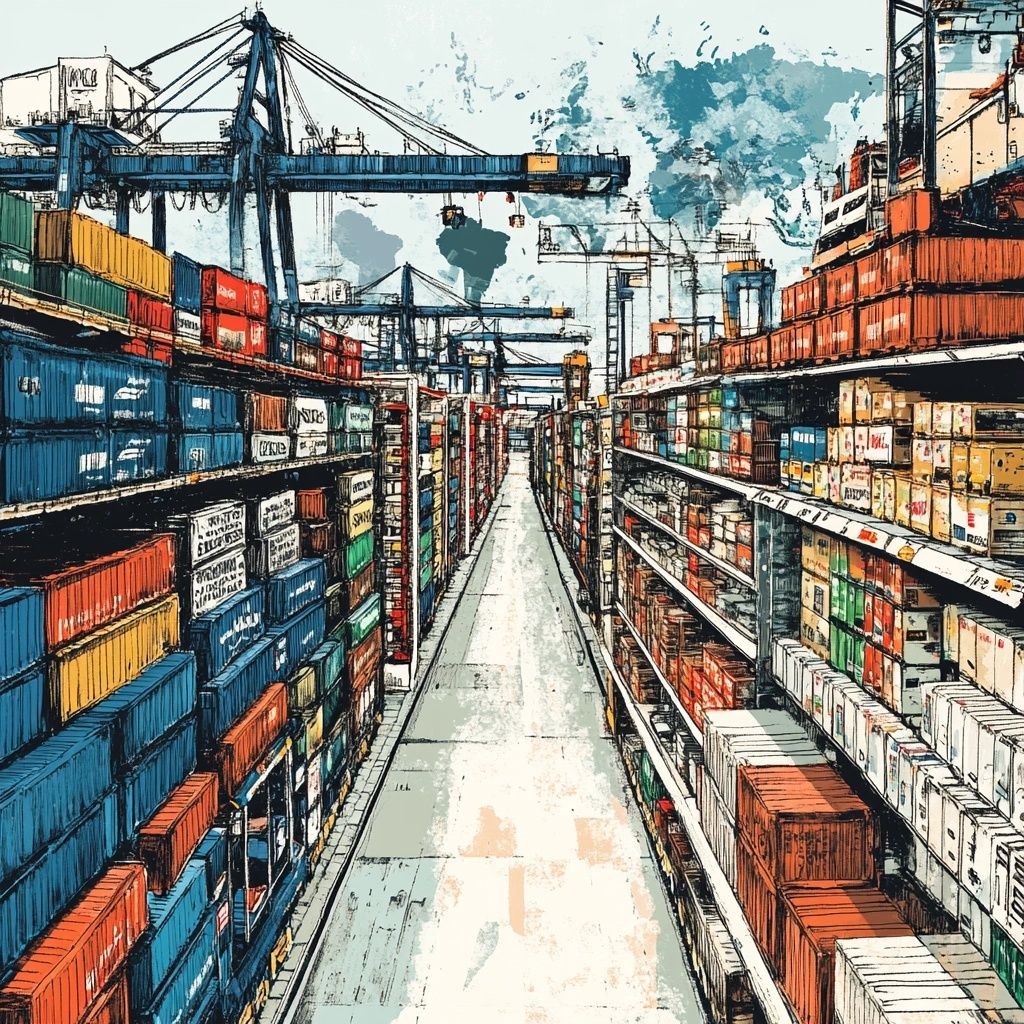- The Anxious Prepper
- Posts
- 🌍 The Ripple Effect: U.S. Tariffs and Global Change
🌍 The Ripple Effect: U.S. Tariffs and Global Change
Rising costs, trade tensions, and what they mean for you.

Hello Everyone,
This week, we’re diving into the impact of new U.S. tariffs on global supply chains and economic stability. From the latest tariff announcements to their ripple effects on consumers, businesses, and markets, this issue explores how these policies might shape 2025 and beyond.
🌐 The Bigger Picture

New U.S. Tariffs: A Growing Economic Tension
President Trump’s recent announcement of sweeping tariffs has reignited concerns about global economic stability. With 25% tariffs on imports from Canada and Mexico and 10% on goods from China set to begin February 1, the fallout could be wide ranging. For example, it could disrupt supply chains, raise costs for households, and strain diplomatic ties with key trading partners.
Key Insight: These tariffs could escalate into broader trade conflicts, triggering retaliation from other countries, reducing global trade, and amplifying inflationary pressures.
Why It Matters: Together, Canada, Mexico, and China represent more than a third of U.S. trade. These measures will likely hit industries such as automotive, agriculture, and electronics hardest, creating a ripple effect that could further weaken economic growth and drive up costs for businesses and consumers alike.
🌟 What You Can Do: Keep an eye on price trends in sectors like food, vehicles, and consumer electronics. If you’re a business owner, consider securing inventory or diversifying supply chains to offset potential disruptions.
🔎 Deep Dive
Tariffs: A Global Domino Effect
The new tariffs are a bold but risky escalation of U.S. trade policy. While aimed at addressing immigration, fentanyl trafficking, and perceived trade imbalances, the actual economic impact is far-reaching.
The Issue
Targeting Canada and Mexico: A proposed 25% tariff on imports from Canada and Mexico is intended to pressure these countries to address immigration and drug control issues. However, these nations are deeply integrated into U.S. supply chains, particularly in the automotive, energy, and agricultural sectors. For example, many car parts cross North American borders multiple times before final assembly, meaning these tariffs could significantly drive up vehicle costs. Not to mention, in 2023, Mexico became the United States’ top trading partner. Hence, imposing 25% tariffs on them has a big impact on U.S. manufacturers.
• China in the Crosshairs: A 10% tariff on Chinese imports targets a wide range of goods, from electronics to textiles. Framed as part of the administration’s efforts to combat fentanyl trafficking, this policy risks further straining U.S.-China relations at a time when collaboration on global issues, such as supply chain resilience, is crucial.
• Global Economic Instability: According to the World Bank, these tariffs could reduce global economic growth by 0.3 percentage points in 2025 if retaliation occurs. Developing economies, already burdened by high debt and low investment, would be particularly vulnerable.
🎯 The Impact
1️⃣ On Consumers:
Higher Costs: Tariffs act as indirect taxes on imported goods, and businesses often pass these expenses directly to consumers. Previous tariffs added an average of $625 annually to U.S. household expenses. These new measures are expected to push that figure higher, particularly for groceries, clothing, and everyday necessities. Nearly 90% of economic experts agree that U.S. households are bearing the majority of tariff-related costs, with price increases especially impacting essentials like food and clothing. Shoppers may see their budgets stretched even further as inflation adds to the burden.
Limited Choices: Rising costs may lead companies to scale back on producing more affordable products, reducing the availability of budget friendly options for consumers. Store brand and generic alternatives, which often cost less, could disappear from shelves, while discounts and promotions may become less frequent as businesses try to manage higher expenses. Experts note that lower income households are hit hardest by these price increases, as their limited budgets leave little room to adapt. For families already struggling to make ends meet, losing access to affordable choices can have an especially severe impact.
2️⃣ On Businesses:
Production Challenges: Companies that rely heavily on imports, such as those in manufacturing, agriculture, and construction, will likely face rising costs and supply chain disruptions. To manage these expenses, some may reduce hiring or even cut jobs, particularly in industries with tight profit margins.
Small Business Struggles: Smaller companies are often less equipped to absorb cost increases or negotiate better supplier deals. These businesses may be forced to raise prices, cut back on operations, or, in some cases, shut down entirely.
3️⃣ On Global Trade:
Retaliation Risks: Mexico, Canada, and China are already planning countermeasures, which could include imposing tariffs on U.S. exports. This could hurt industries like agriculture, where farmers rely heavily on international markets, and energy, which depends on stable trade relationships. Retaliatory tariffs are likely to deepen trade tensions and further disrupt the global economy.
Trade Fragmentation: The increasing reliance on tariffs and trade restrictions may encourage countries to shift away from global trade partnerships toward regional agreements. While this could benefit some local economies, it threatens to reduce the efficiency and benefits of globalization.
4️⃣ On Financial Markets:
Market Volatility: The financial markets have already started reacting to the announcements. Chinese indices, such as the CSI 300, dropped following the news, and the yuan’s depreciation against the dollar signals growing economic uncertainty. Similar market turbulence could ripple across Europe and North America, especially if trade tensions escalate.
🧭 The Perspective
• A Larger Trade Strategy: These tariffs build on a protectionist trend that began in 2018. While aimed at protecting American industries, the unintended consequences, higher prices, reduced output, and job losses have often outweighed the benefits.
• Vulnerable Economies: Developing nations stand to lose the most. The World Bank highlights that these countries are already struggling to recover from the pandemic, with reduced foreign direct investment and slower economic growth making them especially susceptible to trade disruptions.
• Fentanyl and Trade Policy: The Trump administration’s use of tariffs as a tool to combat fentanyl trafficking blends trade and law enforcement strategies in an unprecedented way. Critics argue that this could hinder diplomatic efforts to address the issue collaboratively.
🌟 Takeaway:
These tariffs are poised to reshape global trade and economic stability.
• For Consumers: Budget for potential price increases in key areas like food, vehicles, and electronics.
• For Businesses: Start diversifying suppliers, securing inventory, and exploring domestic alternatives to mitigate potential disruptions.
Quick Hits ❗️
A Snapshot of this week’s global risks and updates:

🔹 Trump Warns Putin: End the War in Ukraine or Face New Tariffs and Sanctions
President Trump has taken a more assertive tone toward Russia, warning that he will impose additional sanctions and tariffs if President Putin does not end the war in Ukraine. While this aligns with his earlier promises of resolving the conflict, it appears to complicate his prior narrative. Trump previously pledged to broker peace within 24 hours of taking office, but his current strategy emphasizes economic pressure rather than immediate diplomacy.
The Kremlin has dismissed these threats as “nothing new,” highlighting the challenges of shifting from campaign promises to the complexities of international diplomacy. Critics note that Trump’s current approach underscores the reality that ending a conflict of this magnitude is far more complicated than it might have initially seemed. For now, Ukrainians are skeptical of words alone and remain focused on actions to achieve lasting peace.
🔹 China’s Markets Hit by Trump’s Tariff Threat
Chinese stocks and the renminbi dropped following President Trump’s announcement of a potential 10% tariff on Chinese imports starting next month, tied to accusations of China’s role in the fentanyl crisis. The CSI 300 index fell 0.9%, while Hong Kong’s Hang Seng index dropped 1.6%, with mainland Chinese companies leading the decline. The offshore renminbi weakened to 7.29 per dollar before recovering slightly. Analysts at Goldman Sachs predict additional tariffs are likely, adding pressure to U.S.-China relations and fueling market uncertainty as traders prepare for continued volatility in currency and equities.
🔹 Singapore’s Prime Minister Warns of a “Third World War” Over U.S.-China Tensions
At an event this week, Singapore’s Prime Minister Lawrence Wong cautioned that forcing countries to choose between the U.S. and China could bring the world to the brink of disaster. While he noted that a full decoupling is unlikely due to economic reliance on China, ongoing disputes, such as the South China Sea, raise the risk of miscalculations. Trump’s proposed 10% tariff on Chinese goods, set for February 1, could further strain relations, with Chinese officials reiterating, “There are no winners in a trade or tariff war.
What This Means for You 🌍
🌐 Tariffs and Rising Costs: Prepare for potential price increases on essential goods like groceries and household products. Stock up on non-perishables, explore local or seasonal options to offset import costs, and switch to generic brands where possible to stretch your budget further. Pay attention to how retailers adjust prices, as inflation and tariffs may lead to higher costs on everyday items.
⚠️ U.S. China Tensions: Trump’s proposed tariffs and renewed trade war rhetoric are creating market instability and could impact global supply chains. While individuals have limited influence on geopolitical shifts, staying informed about developments in key sectors, like electronics and food, can help you anticipate potential price changes or disruptions.
📈 Global Trade Risks: The ongoing tensions between the U.S. and China, combined with warnings from leaders like Singapore’s Prime Minister, underline the potential for broader global instability. Understanding how tariffs, sanctions, and geopolitical disputes trickle down to consumer costs will help you navigate these challenges.
Stay Tuned 🔍
Stay one step ahead in an unpredictable world. Our newsletter delivers expert insights, actionable strategies, and clear takeaways to help you navigate the global shifts shaping your daily life including tariffs, geopolitical risks, market changes, and more.
📬 Don’t wait, Tap the subscribe button below👇 ! Be the first to access critical updates, break down complex global risks, and discover ways to stay prepared. Thousands of readers already trust us to help them make informed decisions and protect what matters most.